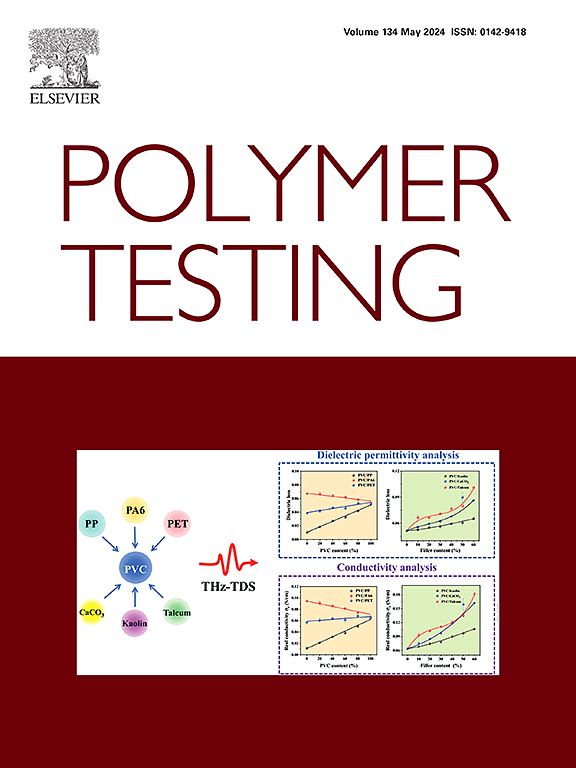Effects of freezing-microwave assisted alkali treatment on physicochemical and thermomechanical properties of bamboo
IF 5
2区 材料科学
Q1 MATERIALS SCIENCE, CHARACTERIZATION & TESTING
引用次数: 0
Abstract
The high lignin content and longitudinally arranged fibers endow bamboo with high hardness and brittleness, but also make it difficult for bamboo to bend or form during processing. To address the above problem, this study presents a treatment method based on freezing or freezing-microwave assisted alkali — sodium hydroxide (NaOH) or calcium oxide (CaO) — softening bamboo, and enhances bamboo stability by adding polyethylene glycol (PEG-4000). The softened bamboo was characterized using chromaticity analysis, microscopic morphology, X-ray diffraction, dynamic mechanical analysis, and contact angle measurement. The treatment of freezing followed by microwaving effectively promoted the hydrolysis of hemicellulose, reduced the crystallinity of bamboo, and increased the contact angle significantly. Therefore, freezing-microwave treatment could better improve the hydrophobic properties of bamboo. The decrease in storage modulus (E′) is an important index to measure the decline in bamboo rigidity. The E′ of NaOH impregnated bamboo decreased from 5159.45 to 314.80 MPa during the freezing-microwave assisted treatment. In contrast, the E′ of calcium hydroxide (Ca(OH)2) impregnated bamboo decreased from 3434.21 to 125.35 MPa. The results indicate the saturation characteristics of the Ca(OH)2 solution better balance the alkali concentration. This mild alkaline environment caused little damage to the internal structure, and better retained the fiber strength and overall stability of bamboo. Notably, the waste liquid of Ca(OH)2 can react with carbon dioxide, and its raw material, CaO, has low cost and a simple production process. This advantage promotes the concept of sustainable development of green environmental protection.
冷冻-微波辅助碱处理对竹材理化和热力学性能的影响
高木质素含量和纵向排列的纤维使竹子具有较高的硬度和脆性,但也使竹子在加工过程中不易弯曲或成型。针对上述问题,本研究提出了冷冻或冷冻-微波辅助碱-氢氧化钠(NaOH)或氧化钙(CaO) -软化竹的处理方法,并通过添加聚乙二醇(PEG-4000)增强竹的稳定性。采用色度分析、微观形貌、x射线衍射、动态力学分析和接触角测量对软化竹进行了表征。冷冻后微波处理有效促进了半纤维素的水解,降低了竹材的结晶度,显著提高了竹材的接触角。因此,冷冻微波处理能更好地改善竹材的疏水性。贮藏模量(E′)的降低是衡量竹材刚度下降的重要指标。在冷冻-微波辅助处理过程中,NaOH浸渍竹材的E′从5159.45减小到314.80 MPa。而氢氧化钙(Ca(OH)2)浸渍竹子的E′由3434.21 MPa降至125.35 MPa。结果表明,Ca(OH)2溶液的饱和特性较好地平衡了碱浓度。这种温和的碱性环境对竹材的内部结构破坏很小,较好地保留了竹材的纤维强度和整体稳定性。值得注意的是,Ca(OH)2废液可以与二氧化碳反应,其原料CaO成本低,生产工艺简单。这一优势促进了绿色环保可持续发展的理念。
本文章由计算机程序翻译,如有差异,请以英文原文为准。
求助全文
约1分钟内获得全文
求助全文
来源期刊

Polymer Testing
工程技术-材料科学:表征与测试
CiteScore
10.70
自引率
5.90%
发文量
328
审稿时长
44 days
期刊介绍:
Polymer Testing focuses on the testing, analysis and characterization of polymer materials, including both synthetic and natural or biobased polymers. Novel testing methods and the testing of novel polymeric materials in bulk, solution and dispersion is covered. In addition, we welcome the submission of the testing of polymeric materials for a wide range of applications and industrial products as well as nanoscale characterization.
The scope includes but is not limited to the following main topics:
Novel testing methods and Chemical analysis
• mechanical, thermal, electrical, chemical, imaging, spectroscopy, scattering and rheology
Physical properties and behaviour of novel polymer systems
• nanoscale properties, morphology, transport properties
Degradation and recycling of polymeric materials when combined with novel testing or characterization methods
• degradation, biodegradation, ageing and fire retardancy
Modelling and Simulation work will be only considered when it is linked to new or previously published experimental results.
 求助内容:
求助内容: 应助结果提醒方式:
应助结果提醒方式:


